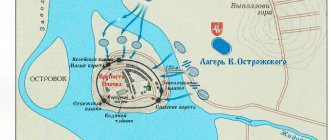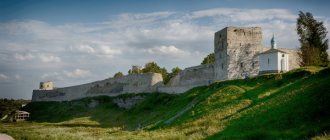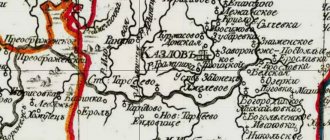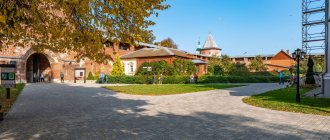30 km west of Pskov, on the way to Livonia, or otherwise the “Land of the Livs,” so named by the German crusading knights, lay the westernmost outpost of medieval Rus' named Izborsk. There was no Pechora Monastery then, and all the functions of the first line of defense were tirelessly performed by this ancient city. There were many wars in those days, attacks on the north-west of Rus' by the Teutonic Order did not stop, but the Izborsk fortress stood firm. And the enemies standing under its high walls admired it, calling Izborsk “Iron City.”
An ancient city stood on a triangular plateau overlooking Lake Gorodishchenskoye, through which the trade route that was just emerging in those days passed. It was surrounded by a wooden palisade, and along the perimeter there was a deep ditch, protected on the sides by stone towers. Archaeological studies of the area, as well as some chronicles, tell us that on the site of Old Izborsk, long before Pskov , the first settlements existed in the 7th-8th centuries, and they were called the city of Slovensk.
Izborsk first mention.
Izborsk was first written about by the monk Nestor in the 12th century, the first Russian chronicler, in the Tale of Bygone Years, in connection with the Varangian princes called to rule Russia. The events described in the “Tale...” are dated 862. The youngest of the reigning brothers, Truvor, was “sideste in Izborsk.” The most ancient settlement on the territory of Izborsk was named in his honor - Truvory settlement. Surrounded on all sides by deep ravines, it was the first defensive outpost in the west. Later, in the 14th century, the fortress was moved to the neighboring hill, Zheravya Mountain. And on the site of the old outpost there remains a rather gloomy old Izborsk cemetery.
LiveInternetLiveInternet
Quote from Oksana_Lyutova's message
Read in full In your quotation book or community!
Cities of Russia.
Izborsk Oh, Russian land! What a great story you have! Your ancient cities and villages are shrouded in legends and myths. There is so much controversy surrounding your story. But it’s not for nothing that you were called the country “Gardarika”. What city in Rus' can be considered the most ancient? A lot of them.
One of the oldest cities in Rus' is Izborsk.
It is older than Pskov, older than other Russian cities and stands on a par with Kiev and Novgorod, Rostov and Smolensk, Ladoga and Belozer, Polotsk and Murom, which celebrated their millennium long ago.
Izborsk is an ancient city located 30 kilometers from Pskov. The first mention of Izborsk in chronicles dates back to 862, where Izborsk is mentioned as the possession of the Varangian prince Truvor, the younger brother of the legendary Rurik. In those days, Izborsk occupied an important place on the trade route that ran along the nearby Gorodishchenskoye and Malskoye lakes, and only in the 10th century the importance of Izborsk as a center of trade began to decrease due to the strengthening of Pskov, which was more advantageously located on a large waterway on the Velikaya River. According to legend, Izborsk was founded by Sloven, the son of Gostomysl, and was initially called Slovensky, and only then was renamed Izborsk - in honor of Izbor, the son of Sloven. The first settlement was located on a triangular plateau above Lake Gorodishchenskoye and was surrounded by a palisade and an earthen rampart. In 1302, the fortress was moved to Crane Mountain, located half a kilometer from the old settlement. Initially, the fortress was wooden, with a single stone watchtower - Lukovka. The first stone walls appeared in 1330. Today the fortress is an irregular triangle with 6 towers. Talavskaya tower and Vyshka tower. Tower Tower is the tallest and most powerful tower of the fortress, which previously served as a watchtower. There was once a watchtower at the top of the tower - hence the name of the tower. Both towers are located on the western, most powerful wall of the fortress, which took on all the sieges.
Northern wall of the fortress.
Korsun Chapel. Built next to the Talavskaya Tower on the site of an ancient burial ground. According to legend, this is a mass grave of Izborians who took part in the defense of the fortress in 1657.
The Talav Tower is the only rectangular tower of the fortress. From the Izborsk website: “Initially, Talavskaya was a carriageway tower and had a powerful zahab - a “corridor of death.” Its entrance gate was connected to a sleeve zahab, which ran between the outer and fortress walls. At the end of the zahab a second, internal gate was built. The enemy, having overcome the first gate, found himself squeezed into a narrow space, which made it impossible for him to fight effectively. It was easier to make a breach in the wall than to storm the gate and overcome the zahab.”
Talavskaya Tower.
Inside the Talav Tower.
North wall.
Cross at the foot of the northern wall. The inscription on the cross reads: “Here lie the soldiers killed in 1657.”
Entrance to the fortress from Lake Gorodishchenskoye.
Lukovka Tower. The oldest tower, remaining from the time of the first wooden fortress. It is especially interesting because it is located inside the fortress walls.
You can climb to the top of Lukovka. The views from there are stunning.
Gorodishchenskoye Lake.
North wall. View from the Lukovka tower.
St. Nicholas Church. Located inside the fortress. Most likely it was built at the same time as the stone walls.
Fortress territory.
Church of St. Sergius of Radonezh. Initially, the wooden church of Sergius of Radonezh was located inside the fortress. After a fire in the 18th century, a stone church was built, but behind the fortress walls. The church is a simple building with a gable roof, surrounded by a low wall. The two-span belfry, which serves as the main façade of the building, is very interesting.
Crosses on the church grounds.
Slovenian keys. They are a powerful outlet of karst waters. Water is collected over an area of three to four kilometers. Powerful streams of water beautifully fall at a speed of more than 200 liters per minute. The keys are believed to be at least 1000 years old. Even in ancient chronicles it was stated: “Thirty miles to the west from Pskov, the city of Izborsk stands on the Slovenian Springs.” The ruins on the right are the remains of a water mill that stood here until the 30s of the 20th century.
Since ancient times, Slovenian springs have been revered as healing and miraculous, which attracts many pilgrims from all over Russia.
There are many legends associated with the Slovenian Springs. Here is one of them (taken from the Izborsk website): “One day the water in the springs dried up. One pious young man, who had recently lost his mother, whom he dearly loved and revered, began to pray at night for help in giving water to Izborsk. And one day in a vision he was told that if the residents of the city named the springs in honor of the Twelve Apostles and served them a prayer service, then the water would appear again. And so it happened.”
Gorodishchenskoye Lake.
Old Izborsk cemetery.
Truvorov cross. The gloomy, time-corroded pedestal, as if straight out of the pages of “The Lord of the Rings,” creates a unique atmosphere in which the legends of distant antiquity soar. It is believed that the tomb of the legendary Truvor is located here. A huge, human-sized cross was erected several centuries later. Around there are several ancient slabs with strange geometric designs called “Babylons”, which are most likely military graves.
Izborsk Valley. The Truvorovo settlement was once located on the hill.
Church of St. Nicholas. It is located on the edge of the settlement, next to the cemetery. The church was built at a time when life on the site had already come to a standstill; at the time of construction, there was a monastery here.
Being an example of Pskov architecture, the church looks very unusual.
Restored gates that once led to the fort.
A triangular plateau on which in ancient times the first settlement was located - Truvorovo settlement. Its territory was quite small and occupied the top of a hill, the foot of which sharply slopes down to the bottom of the valley, making the plateau on this side practically impregnable. In the foreground are the remains of earthen ramparts - one of the oldest fortifications in Russia.
From the plateau there is a stunning view of the Izbro-Maly valley.
A stone on top of an earthen rampart in honor of the conclusion of peace with Estonia.
View from the ramparts.
A LITTLE HISTORY
By the middle of the 10th century, Izborsk was already an early medieval city, with a princely squad and a craft settlement. After a big fire that happened in the first half of the century, it was rebuilt, its territory increased significantly and amounted to 9,500 sq.m. The population of the ancient city was engaged in agriculture, fishing, crafts and trade. Moreover, during excavations in Izborsk, objects were discovered brought from Kyiv, Byzantium, Syria, Africa, the Baltic States, Scandinavia... But the most important thing for the Izborians was the protection of the western borders of the Pskov land. By the end of the 10th century, Izborsk became a fortress city, an outpost on the northwestern borders of Rus'. By this time, the administrative and economic functions of the center of the region are transferred to Pskov, which has a more advantageous geographical location, and Izborsk is gradually turning into a suburb of Pskov, but retains its important strategic and defense significance.
In the first half of the 11th century, stone fortifications were erected and a powerful defensive complex was created. Such serious precautions were caused by growing aggression from the West. Over two centuries - from 1030 to 1233 - the Pskov chronicles recorded only 20 major clashes with external enemies. The constant ill-wishers of Novgorod and Pskov - the Finns and Swedes - were joined at the end of the 12th century by the Germans, who formed two military monastic Orders on the southern coast of the Baltic Sea - the Order of the Swordsmen in Livonia and the Teutonic Order in Lithuania. Having declared a crusade against pagans and peoples of non-Catholic faith, the German knights, completing the conquest of the Baltic states with the capture of Yuryev (Tartu) in 1224, paved the way to Pskov and Novgorod.
In the 30s of the 13th century, the heroic struggle of Izborsk began with a new formidable enemy - the Livonian knights (this is how the Swordsmen and Teutons, united in 1237, called themselves, and the Baltic lands they conquered began to be called Livonia).
The struggle with the Livonians will last for centuries. It will begin in 1233. Then Izborsk was captured by “expulsion” - an unexpected, sudden attack, and then recaptured by the Izborians and Pskovites.
But the year 1240 would prove fatal both for Izborsk and for the entire Pskov land.
The hordes of Batu were already in charge in Rus', the Swedes were threatening Novgorod, and the Livonians were threatening Pskov. When a large, well-trained Livonian army captured Izborsk, the Pskovites hastily moved to the walls of the fortress city, but they were unable to defeat the enemy. In a bloody, brutal battle, at least 600 Russian soldiers were killed.
Following Izborsk, Pskov fell. The Germans ruled it for two years, making unhindered raids on the Novgorod lands, subjecting them to robbery and ruin. Only in 1242 did the Russian army, led by Prince Alexander Yaroslavich Nevsky, manage to liberate Russian cities and villages and defeat the German knights on the ice of Lake Peipsi.
However, the Livonians were not going to give up their aggressive plans. In 1262 and 1289 they again crossed the western border of Rus', and again the warrior city of Izborsk, famous for its steadfastness and courage, stood in their way. It is no coincidence that the field on the approaching side to the west of the fortress was called Shibalitsa in ancient times: it was where the Pskovites clashed with the conquerors. It was possible to expand and strengthen the fort only in a new location. At the beginning of the 14th century. Pskov carried out large-scale defensive construction. Special attention was paid to the advanced outpost of Izborsk.
Under 1303 Chronicles report that “Izborsk was in a new place.” He was found nearby - one and a half kilometers to the east, on the edge of Zhuravya (that is, Crane) Mountain.
Moved to a new location, Izborsk apparently initially had wooden fortifications, with the exception of the Lukovka (Kukovka) tower located on the eastern wall. Round in plan, it adjoins the walls from the inside. This means that the tower originally stood separately.
In 1323, the Livonians moved to Pskov, bypassing Izborsk. The siege of Pskov lasted 18 days, and now the Izborians, led by the Izborsk prince Ostafiy (Eustathius), hastened to help the Pskovites who were in trouble. By striking from the rear, they helped defeat the treacherous enemy, and he had no mercy from them.
Until the beginning of the 16th century, the Izborsk fortress, having withstood eight major sieges, never surrendered to enemies in open battle.
The Livonian knights made their first attempt to take the new fortress in 1341. Then the Pskovites fought against them together with Lithuania. The siege of the fortress lasted 10 days. The Izborians and Prince Yuri Vitovtovich decided to defend themselves to the last possible opportunity. On the south-eastern side of the fortress there was a hiding place - a narrow corridor 40 m long, the walls and gable arch of which were lined with flagstone. Laid underground at a depth of 16 m, it descended to the spring from the foot of the cape. The difficult task was to provide reliable shelter for the cache. The Livonians managed to discover the cache and deprive the Izborians of water.
The city was left without water and was “on the verge of death,” and suddenly, unexpectedly, the Germans lifted the siege and retreated. “God protect the city and the people living in it, and put fear into their hearts of the filthy and turn them to run,” this is how the chronicler explains the miraculous salvation of the Izborians. They once again showed their inherent courage, managing to detain the Livonians at their walls and save the entire Pskov land from robbery and ruin.
The peaceful respite did not last long. In 1367-1369, the Livonian knights tried three times to take possession of the “iron city”. The longest siege of the fortress was in 1368. It lasted 18 days with the use of throwing and battering weapons. The fortress walls withstood the crushing blows of the Livonians, and the Izborians survived, despite seemingly impossible trials.
By the end of the XIV - beginning of the XV centuries. In connection with the increased power of siege artillery and the appearance of firearms, the Izborsk fortress was further strengthened: new towers were erected, and the walls became even stronger. The protector of Izborsk, the stone fortress, scares off the enemy with just her formidable appearance. In 1406, a large Livonian army, burning villages on the approach to the city, did not dare to storm the fortress. And in the same 1406, the Pskov suburbs, joining forces, repelled Lithuania, which treacherously attacked the Pskov land.
At this time, Pskov residents are increasingly turning to Moscow for help to resist the aggression of the Livonian Order and the Grand Duchy of Lithuania, which has come into force. In 1463, under Grand Duke Vasily III, Izborsk became a gathering place for the Russian army. From here, Pskov and Moscow troops are sent to Neuhausen (“New Town”, modern Vastseliina), as a result of the successful siege of which the Livonians were forced to recognize the rights of Rus' to Yuryev, undertaking to pay a duty. In 1480, the Germans, in alliance with the Estonians and Latvians, launched a new campaign against Pskov and Izborsk under the leadership of the Master of the Livonian Order von der Borch. Izborsk is besieged twice. During its siege, firearms were used, which, however, did not help the enemy capture the city engulfed in fire. Pskov also did not submit to the conquerors. The Russian success was secured by the capture of the two largest castles in the Baltic states.
This is how the united twenty thousand Russian army responded to the aggressive plans of the enemy.
At the very beginning of the 16th century - in 1501 and 1502 - the attempts of the Livonian knights to conquer Izborsk and Pskov also failed. They returned home with the remnants of their army.
The most important event of this century was the annexation of the Pskov land to Moscow in 1510. Considering the commercial and strategic importance of these lands, the government of Vasily III strengthens Pskov. In Izborsk, along with strengthening the northern wall of the fortress, devices for cannon combat were installed on the towers (after their reconstruction), and 18 kilometers away in 1558, construction of fortifications of the Pechersky Monastery began. The new fortress will cover Izborsk from the western border, but will not detract from its defensive role. The permanent garrison of Izborsk included 100 archers, 15 gunners, and 4 collars. For more than 50 years, Izborians have not seen foreign invaders near their walls.
In the second half of the 16th century, the Russian state sought to win access to the Baltic Sea, but Livonia prevented the implementation of its plans. In 1558, the Livonian War began, the reason for which was the failure of the Livonians to pay the tribute established in 1463. Izborians also took part in the campaigns against Livonia. In the spring of 1558, Russian troops took Rugadiv (Narva), in the summer - Yuryev (Tartu), in 1560 - Neuhausen (Vastseliina). The rest of Livonia surrendered to the mercy of Sweden, Denmark and the Polish-Lithuanian state, which immediately began to lay claim to the Baltic lands. After the defeat of the Livonian Order, the most dangerous of the enemies of Rus' turned out to be the Polish-Lithuanian Commonwealth.
During the time of Ivan the Terrible, the fortress faced difficult trials. In January 1569 the so-called “Izborsk treason” occurred among the Lithuanian governors, as S. Soloviev writes. “We accidentally took possession of Izborsk.” Russian traitors Timokha Teterin and Mark Sarykhozin disguised themselves as guardsmen and ordered the guards to open the gates at night and let them in. Izborsk underwent severe trials during this period. Having learned about the treacherous capture of Izborsk, Tsar Ivan the Terrible ordered his commanders and boyars to release it. The Russian army went to the fortified city, and the two-week domination of the Lithuanians ended in their defeat.
But the tsar did not ignore the story of the capture of Izborsk: in 1570, after conducting an investigation on the spot, he executed the unreliable people suspected of a “treasonable deed.” Repentant and in atonement for his sins, Ivan the Terrible ordered two bells to be cast for the nunnery of the Nativity of the Virgin Mary in Izborsk.
In the 17th century, Izborsk continued to retain its important strategic importance. However, now his participation in events is often connected with internal processes taking place in Russia, with popular movements and unrest.
During the peasant war, in 1607, crushed by “untruths and violence,” the common people swore allegiance to False Dmitry II, believing the promises of his henchmen. Izborsk was among the first to rebel against the legitimate government. But among those who swore allegiance to the “autocrat” there were no Pskovites, and then, trying to force them to swear the oath, the Izborians went on a campaign against Pskov. In the battle on Riginaya Mountain, near Kamno, the Pskovians gained the upper hand. This was the only case in the entire centuries-old history of relations between Pskov and Izborsk when comrades and brothers found themselves on opposite sides of the same battlefield.
The threat of the Poles ruining the Pskov land soon unites their efforts again. Pan Lisovsky, who came with False Dmitry II, devastates cities and villages. In the battle under the walls of Izborsk, the invaders learned a good lesson and were forced to retreat to the Lithuanian border. But after the battles with the Polish lords, the city became deserted and collapsed. For the Izborians, the fight with Lithuania brought no less grief than the war with the Livonians.
In 1655, Russia was at war with Poland, and laconic reports were sent from Izborsk to Moscow with information about the number of the enemy on the Lithuanian border and the actions they were taking. In a mass grave of 1657 near the northern wall of the fortress, its defenders - Izborians, participants in the Polish War - found their final refuge.
The military significance of Izborsk remained almost until the end of the 17th century. By the end of the 17th century, its population was halved. The absence of townspeople, serving nobles and even state-owned blacksmiths and carpenters negatively affects the economic condition of the city. Its decline can be explained by the fact that the trade route to Riga and Yuryev began to pass northwest of Izborsk from the 16th century - through the Pechersky Monastery.
From the beginning of the 18th century, Peter I began to fight for access to the Baltic Sea. The Northern War ended victoriously for Russia. According to the Peace of Nystad, concluded in 1721, Livonia, Estland, Ingria, the Karelian Isthmus with Vyborg and Kexholm went to Russia, and accordingly its border moved to the sea itself.
From that moment on, Izborsk, on which the fate of the Pskov land and the fate of Rus' depended for six centuries, obediently followed the dictates of other times, resigning itself to its new modest role.
The further life of the former arbiter of destinies was not much different from the life of other Russian villages and settlements, but the proximity to the Baltic border still brought anxiety into his measured existence. The first half of the 20th century was marked by a number of upheavals.
In October 1917, when all of Russia was turned upside down, part of the population of Izborsk reacted with sympathy to the establishment of a new social system. Izborians participated in the seizure of landowners' estates and suppressed attempts to change the course of events. In February 1918, the Germans occupied Latvia, Estonia, part of Ukraine and, threatening Petrograd, captured Pskov, and soon occupied Izborsk and Pechora volosts. And although the German occupation did not last long, it left a heavy mark on the memory of the inhabitants of the Pskov region. A little more than two months passed, and the White Estonian troops rushed to Pechory. The city passed from hand to hand. At the end of March 1919, the White Estonian landing force, having again captured Pechory, occupied Izborsk. With the appearance of the White Estonians, arrests began. Six fighters for the establishment of Soviet power were executed. In memory of them, a monument was erected at the cemetery near Ts. Sergius of Radonezh. After the end of the civil war in February 1920, the Tartu Peace Treaty was signed between Estonia and Soviet Russia, according to which Pechory, Izborsk and its environs went to Estonia.
For 20 years - from 1920 to 1940 - Pechory and Izborsk were part of Estonia. Finding themselves a national minority, the Russian population of Izborsk sought to preserve the culture and traditions of their people. The “Russian Cultural and Educational Society” was created, which, among other things, was engaged in the protection of the historical heritage of the Izborsk region. In August 1940, Estonia became part of the Soviet Union. The city of Pechory remained a district center and, together with Izborsk and other settlements, became part of the Estonian SSR.
During the Great Patriotic War, Izborians fought heroically for the Fatherland, just like their distant ancestors. From the very first days of the war, a youth fighter squad was created in Izborsk, whose members subsequently fought on different fronts. In Izborsk, Panikovichi and the surrounding area of Pechory, the Germans built several concentration camps. Hundreds of innocent people were tortured there. The partisan movement that swept the Pechora region caused great damage to the Nazis. The Izborians were responsible for daring raids into the lair of enemies. The fight against fascism behind the front line brought victory closer. On July 30, 1944, Izborsk was liberated by troops of the 3rd Baltic Front. The 291st, 376th rifle divisions and other formations of the Soviet Army also took part in the liberation of Izborsk and Pechora.
Objects made of non-ferrous metals found during excavations of the Izborsk ancient settlement
pin with a triangular head, equal-armed brooch, pendant, Korelian-type brooch (above); sword scabbard tip, bell, mace, chain (bottom)
Iron knives with bone handles and a folding comb from the excavations of the Izborsk ancient settlement
Bronze lock and duck pendant from the excavations of the Izborsk ancient settlement
Massive finds include bracelets, rings and horseshoe clasps.
In Izborsk they were also involved in the processing of bone and antler, as evidenced by the finds of bones with traces of processing, defective semi-finished products, as well as numerous bone products - solid double-sided and composite combs, folding combs, handles of knives and awls, various washers and playing chips.
Among the Izborsk finds there are numerous beads - gilded glass, barrel-shaped or cylindrical, blue, turquoise and yellow, paste black ocellated, one slate. Pendants made from cowrie shells have been found many times. An interesting amber cross with an Old Russian inscription.
The Izborsk fortress on Zheravya Mountain, having steadfastly withstood many blows from battering machines, cannonballs of vices and artillery shelling, has been well preserved to this day; it is a remarkable monument of Pskov defensive architecture.
sources: https://interesnayarossiya.ru/stary-izborsk/ https://kezling.ru/travels/pskov-trip-3/2638368/ https://www.rusarch.ru/sedov19.htm
Prince Truvor.
If you walk through this cemetery to the end, it is difficult not to notice a huge stone cross with barely visible writing. Legend says that under this cross, at a depth of more than two meters, lies Prince Truvor... According to one version, this cross dates back to the era of the XIV-XV centuries, and was erected here in memory of the old outpost, the first ancient settlement, from which it began defense of Rus'. Another version says that... in fact, why couldn’t this cross be placed on the site of Truvor’s grave? This is also a fairly fair remark.
How to get there
- By bus from Pskov a . In this case, the final stop will be the Old Izborsk car pavilion. The city of Pskov is located 30 kilometers east of the village, and in addition to the Pskov-Izborsk buses, which depart twice a day, those that go to Pechory and depart from the Pskov bus station every 1-2 hours, stopping along the way to Izborsk. How to get to Pskov depends on where you live, but in most cases the best way to do this is by train. The cost of a bus ticket will be about 120 rubles.
- As part of the excursion . Pskov, Izborsk and Pechory are now very popular among tourists traveling around Russia, so bus tours to these places are organized by many agencies in Moscow and St. Petersburg. Most often, a visit to Old Izborsk is combined with Pechory, but there are also more intense excursion tours. The cost can be completely different: from several hundred rubles to several thousand, depending on the place of departure, the organization of meals and accommodation and, of course, the composition of the excursion. Izborsk, in my opinion, is not a place that takes a couple of hours to get to know, but if you don’t want to spend time organizing a trip and planning your route yourself, this option will suit you best.
- By your own car. In this case, you need to take the A-212 highway, also known as E-77 Riga-Pskov. Turning along the sign, we immediately find ourselves on the main street of Old Izborsk, Pechorskaya. You can park in the area of the Izborsk Park refectory, just before reaching the fortress, but under no circumstances should you leave your car on the historical paving stones of Pechora Street.
Church of St. Nicholas the Wonderworker.
Very nearby, on a high hill, stands the Church of St. Nicholas the Wonderworker, and in the evening twilight its white walls with black crosses look truly terrifying. Once upon a time there was a wooden building in its place, replaced in the 15th-16th centuries with a stone one, and only then in the 17th-18th centuries rebuilt into what we can see now. From the Truvorov settlement, from the very top of the hill, a magnificent view of Gorodishchenskoe Lake opens.
Excursion routes
The excursion “By bike around Izborsk” begins on Pechorskaya Street, continues to the Truvorov settlement ensemble, then along field roads to the village of Malo (museum of the Seto people), from there to the Malsky Monastery. The end of the route on Pechorskaya Street with a visit to the Slovenian springs. Cost for 1-5 people 4380 rubles, duration 2-3 hours, range about 9 km. Adults only.
The walking tour “Understanding Izborsk in 2 hours” starts from the Truvorov settlement complex, moves to the Slovenian Keys and Gorodishchenskoe Lake, then visits the fortress and St. Nicholas Cathedral. Cost for 1-7 people 2500-3000 rubles, duration 2-3 hours.
The Izborsk car tour route covers the main attractions: Truvorovo ancient settlement, Slovenian springs, the fortress with St. Nicholas Cathedral and merchant houses in the Museum Quarter. If desired, stop at a cafe for lunch. Duration 3 hours, client transport or rental, cost 2000 or 4000 rubles. respectively.
Slovenian keys.
If you go down and walk along the bottom of the hill, then between the Truvor settlement and the Zheravya Mountain, numerous Slovenian springs gush out from the limestone cliff, more than a thousand years old. The springs merge into a single stream, called the “River of Life,” which flows into Lake Gorodishchenskoye. Since time immemorial, keys have been considered miraculous and have holy healing powers. They consist of twelve jets, each of which has its own name, corresponding to one of the twelve months of the year.
"The city of St. Nicholas."
Let's return to the fortress. To get beyond the walls of the Izborsk fortress, you need to overcome the Nikolsky Zahab, a long narrow passage running along the internal and external gates located in the southern wall. As soon as you get inside, your gaze immediately stops at the Temple of St. Nicholas, sparkling with its silver dome. It was erected here immediately after the fortifications were moved to Zheravya Mountain in 1302. In 1349, it was already mentioned in the chronicle, telling about another enemy attack on the Izborsk fortress. In ancient times, the Izborians called their city “The City of St. Nicholas,” and the temple itself was nothing less than “his home.” That is why St. Nicholas Cathedral has a special significance. The concepts of “St. Nicholas Church” and “Izborsk” were closely intertwined.
Modern objects interesting to visit
Izborsk, whose sights date back to different historical eras, has modern interesting objects.
Memorial Sacred Hill
In the fall of 2007, a Poklonny Cross was erected to the side of the fortress as a symbol of the memory and glory of the people of Russia. The defenders of Izborsk fought at this place; fallen soldiers and townspeople who stood shoulder to shoulder were buried here. The 8 m high cross is mounted on a hill-shaped foundation made of large boulders.
At its base, soil was poured from many cities and villages, from battle areas of different times, from the graves of prominent figures. Until now, guests who specially come to the Sacred Hill memorial take the soil with them.
In 2012, the chapel of the Sovereign Icon of the Mother of God, built near the Worship Cross, received its first visitors . The small temple does not violate the general architectural style of the churches of Izborsk.
Hotels
Hotel complexes in Izborsk fit into the appearance of a historical place, offer a break from the noisy city with a stove or fireplace, a Russian bathhouse, and provide modern amenities.
Hotels:
- The guest house of the Izborsk Museum-Reserve was built near the fortress and Slovenian springs. Its appearance resembles typical Pechora houses - the lower floor is made of limestone slabs, the upper floor is wooden. The interiors are designed in Russian style, the rooms are heated, you have the opportunity to use the kitchen or go to the museum cafe. The hotel accepts no more than 20 people. The possibility of booking must be clarified by phone or email.
- Guest complex "Izborsk" represents a group of merchant estates after restoration. The houses are architectural monuments of the late 19th – early 20th centuries. Guests can enjoy comfortable rooms with modern amenities, a safe, heating and air conditioning. Daily cleaning is required. There is a business center, secure parking, and bicycle rental. Active recreation options: horse riding, fishing, cycling, board games. Services: free Wi-Fi, laundry, ironing, transfer from/to Pskov, parking. For children there is a playground on the street, a play area in the house, animators, children's TV channels, and a separate menu. The restaurant has indoor and patio seating. You can order lunches delivered to your room or packed breakfasts to take with you on your walk. Smoking is prohibited; there are special areas for this. Check-in at 14:00, checkout until 12:00. Address: st. Pechorskaya, 13, not far from the fortress.
- The Izborsk Park guest complex consists of several wooden houses, a Russian bathhouse, and a refectory. Modern rooms are decorated in Russian style with elements of rustic interiors, daily cleaning is guaranteed. There is everything for relaxation - stoves, heated floors, TV, bathroom. There is an outdoor playground and a separate playroom in the house for children. You can order grocery delivery, lunch to your room, or breakfast to take with you for a walk. Fans of active recreation are provided with rental bicycles and tennis tables. There is secure parking on site. Transfer from/to Pskov is available by prior arrangement. Check-in at 14:00, checkout until 12:00. Address: st. Pechorskaya, 43, not far from the fortress. Smoking is prohibited; there are special areas for this.
| Name | Price, rub./day | Note | Animal accommodation |
| Museum Guest House | 1500 — 3500 | Check prices by phone | Check by phone |
| Complex "Izborsk" | 1900 – 4700; apartments 7000 – 9000 | Breakfast included | Paid separately |
| Complex "Izborsk-Park" | 2500 — 5000 | No internet, cash payment | Paid separately |
In Izborsk hotels you can book interesting excursions or just relax.
Lukovka Tower.
If you walk around St. Nicholas Cathedral counterclockwise, you can go straight to the most mysterious tower - Lukovka (or “Kukovka”, as it is also called), the only one located inside the fortress walls. It has been preserved since the days of the wooden fortress, and subsequently became a “fortress within a fortress”, the last refuge in the event of the city being captured by enemies. The lower part of the tower has an arched opening, which in the distant past served as an arsenal and gunpowder was stored in it. In addition, it served as a watchtower. A long staircase with high, difficult steps leads to the upper part of Lukovka.
St. Nicholas Cathedral of the Izborsk Fortress
In the very center of the fortress is St. Nicholas Cathedral, which dates back to the 14th century. The cathedral was the political and social center of the life of the fortress, similar to Trotsky's cathedrals in the Pskov Kremlin, and was extremely important. Izborians affectionately and respectfully called the cathedral “St. Nicholas” or “the house of St. Father Nicholas.” The cathedral is unique in its architecture, so be sure to visit it. The main vaults of the Cathedral have no analogues; they seem to be assembled from narrow arches.
St. Nicholas Cathedral
St. Nicholas Cathedral
Lukovka Tower.
At the very top there is an observation deck. Now anyone can get here by paying the entrance ticket at the ticket office nearby. From here you can admire the magnificent view for a long time. The restoration brought its share of changes to the internal appearance of the ancient Lukovka, and everything does not look quite the same as it might have looked in antiquity. But the panoramic view from above has remained virtually unchanged. Considering the perfectly visible space over which Lukovka rises in the impregnable part of the fortress on the top of the mountain, it is easy to imagine why at one time it performed excellent patrol functions.
Izborsk Talavskaya Tower.
Further along the wall stands the only tower that has retained its rectangular shape, Talavskaya. Next to it was the Talavsky Zahab, in ancient times better known as the “corridor of death.” It was surrounded on both sides by gates, and the enemy, having passed through the first gate, found himself trapped in a narrow space, where he suffered inevitable defeat. Coming back outside the fortress walls through the Nikolsky Zahab, and moving clockwise along them, we see the remaining defensive structures. Ryabinovka is a six-tiered fortress tower with a special threatening silhouette.
Izborsk Tower Tower.
Almost close to the Tower there is a cross made of stones - one of the attributes used to raise the morale of the fortress’s soldiers and confuse the enemy. And here is the HSE itself. The tallest tower of Izborsk, which at one time served as an observation post, once had a two-tier wooden lookout on its top. Now its height is 19 meters, and in the past it was even higher.
House of merchant Shvedov
Merchant Shvedov is a wealthy entrepreneur of pre-revolutionary Russia, engaged in the trade of flax and printed material. In Izborsk he had a small estate, including a wooden one-story house and outbuildings - a stone barn and a bathhouse. After his death, the estate became the property of his nephew, and in 1988 it entered the balance of the Pskov region, with the participation of which a unique museum was organized dedicated to the culture and life of the Finno-Ugric Seto (Seto) tribe.
In ancient times it was called the Pskov Chud. The basis of the museum exhibition is made up of unique ethnographic materials found during expeditions in the Pechersk region over the past 30 years. Visitors can also get acquainted with the interior of the house of a wealthy citizen of the 30s of the 19th century . The museum's collection contains unique photographs, merchant household items, as well as original furniture that has survived to this day.
The exhibition dedicated to the set will introduce visitors to traditional clothing and household items - spinning wheels, dishes, ritual towels and tools. A special place is occupied by the collection of samovars, both factory-made and handicraft. The decoration of the museum is a working German harmonium from the 19th century .
Address : Pechorskaya st., 32, Izborsk, Pskov region, 181518
Bell Tower.
Between the Talavskaya Tower and Lukovka there is another cross dug into the ground. The following words are still visible on it: “In this place lie the soldiers killed in 1657.” This cross was erected in the 19th century. The bell tower is a typical fortification of its kind from the early firearms era. Until the 19th century, there was a solid bell on it, warning residents about the approach of the enemy; its roar could be heard in Pskov
!
Where to eat
Despite the fact that the Izborsk Museum-Reserve occupies an impressive territory, all hotels and food outlets are located at the entrance to the village. Personally, I had the opportunity to dine at the repeatedly mentioned Izborsk Park refectory. The establishment is very colorful, furnished in the spirit of a Russian hut of the 19th century, the portions are quite large, and the average bill for two without alcohol will be about 1,500 rubles. You can recognize the refectory by the not-so-modest inscription on the façade.
To summarize all of the above, I want to say that Izborsk can rightfully be considered one of the main attractions of the Pskov region. This place is well worth visiting on purpose, without combining it with other historical sites, but even if you decide to visit Pskov, Old Izborsk will be a great addition to your trip.
Izborsk Temnushka and Ryabinovka towers.
Temnushka is extremely similar to Ryabinovka. These two towers covering the western part of the wall bore the main blow of the enemy, because he, for obvious reasons, preferred to attack the fortress from the accessible side. Two zahabs, Nikolsky and Talavsky, were a good barrier to the enemy entering the city through the fortress gates. An obstacle, and at the same time a dangerous trap.
Estates
All lovers of ancient museums can visit several estates that have been preserved in Izborsk.
- Estate of I. A. Anisimov. Built in 1902. The building has several halls with museums of ancient objects and weapons.
- The estate of the merchant M. S. Belyanin. Created in 1895. In the house you can see old things, furniture, dishes, sculptures, paintings, books. They used to watch movies here, some of the films have been preserved and restored.
- Shvedov's estate. In the halls of this museum you can feel the time in which the merchant lived, look at objects, furniture, dishes, toys.
You can book excursions to the city with an accompanying person, or you can see all the sights on your own. Tourists visiting Izborsk can take a break from noisy cities, enjoy rich nature and silence, and plunge into the atmosphere of antiquity.
Izborsk fortress walls.
The total length of the fortress walls of Izborsk is 623 meters. The thickness reaches 4 meters, and the height varies between 7 and 10 meters. Next to the Talavskaya Tower is the Korsun Chapel. On its icon case there is an ancient Slavic inscription: “The chapel project is a gift from the artist, architect A. I. Vladovkago.” At the beginning of the 14th century, a wooden temple of Sergius of Radonezh stood on the territory of the Izborsk fortress. After it burned down in the 18th century, it was decided to rebuild a new church in its place, which was named in honor of Sergius and Nikander. True, its location differed from the old temple in that it was located outside the fortress wall.
Top 5 places suitable for holidays with children
Izborsk, whose attractions attract tourists of different age categories, is interesting for children:
- In the Izborsk fortress you can listen to a story about its history, go down the secret passage or into the powder magazine, walk along the walls, look at ancient cannons, and climb the Lukovka tower.
- In good weather, a walk to the Slovenian springs is possible.
- The Izborsky Ostrich eco-farm is home to not only exotic birds, but also reindeer, Romanov sheep, rabbits, raccoons, squirrels, and geese. You can feed the animals and play on the playground.
- The Museum of the History of Izborsk (house of the merchant Anisimov) has an interesting collection of equipment and weapons of warriors from different countries and times. You can hold some exhibits in your hands.
- If you come with children in early August, you can go to the Iron City festival: a crafts fair, tournament battles of horsemen, archery competitions, foot fights and the performance of a 15th century battle. The finale includes a concert and fireworks.
It is necessary to have comfortable shoes and a supply of dry clothes for a walk to the springs.











